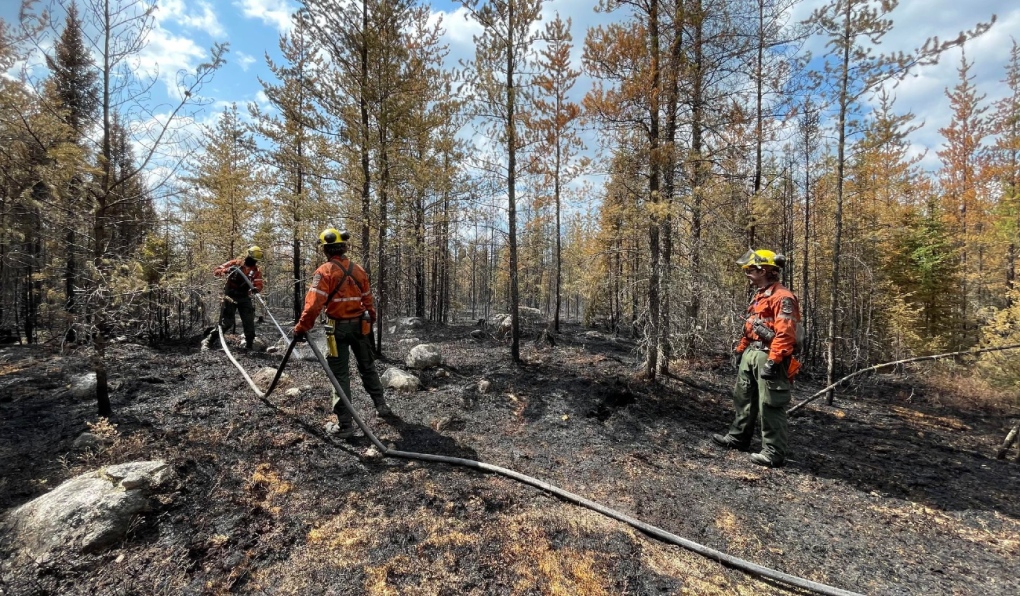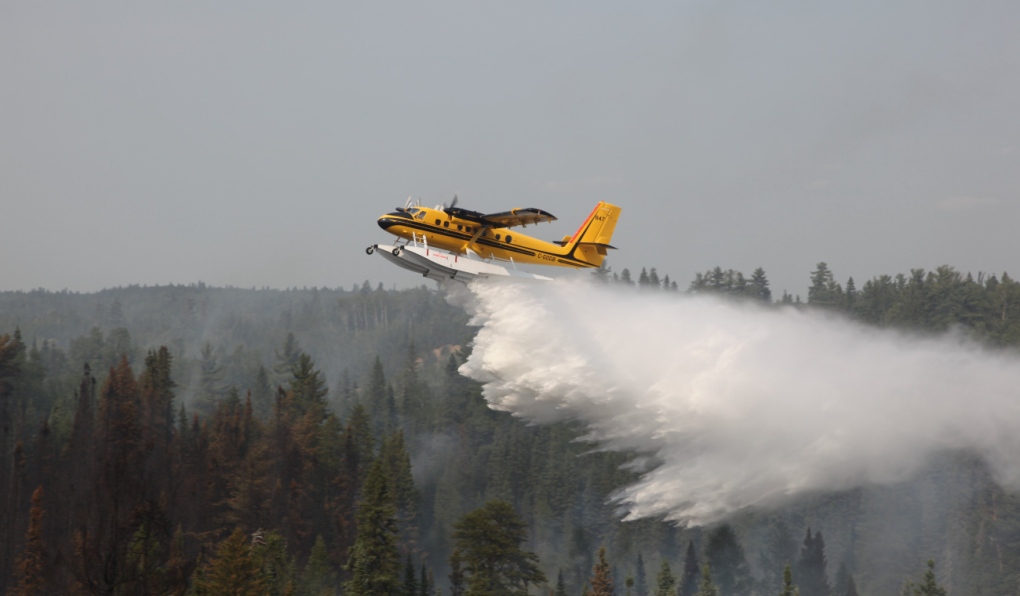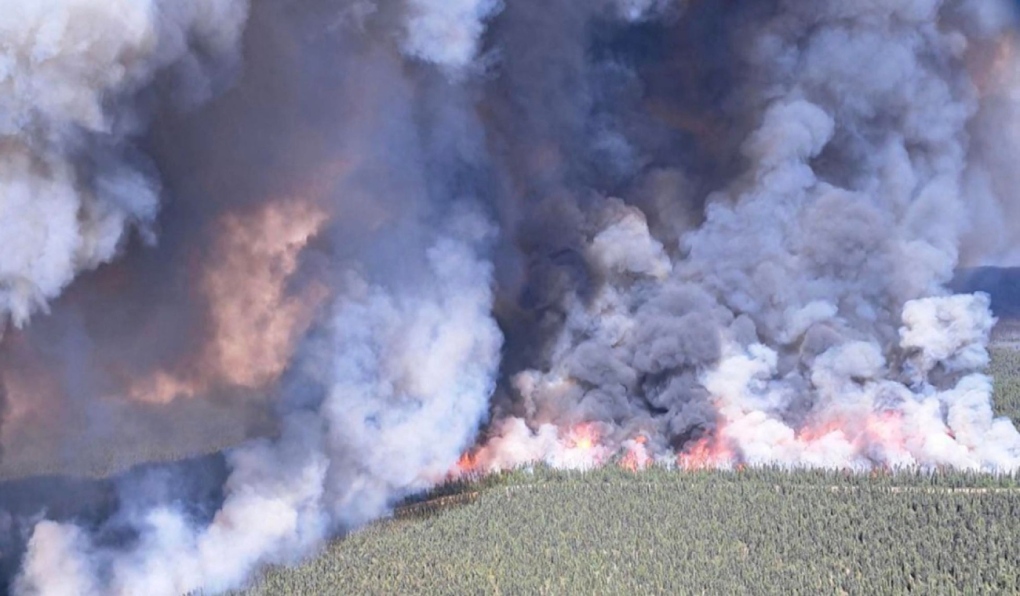Small northern Ont. airport assisting MNRF with the forest fire situation
Hot, dry temperatures are not helping the current wildfire situation. There are currently 27 active forest fires burning in northeastern Ontario.
But through this time of scorch and flame, a small regional airport has been a key pit stop in helping helicopters refuel before they need to get back in the sky en route to fight these fires.
For weeks, the tarmac at the Earlton-Timiskaming Regional Airport has seen a lot of helicopter traffic.
“We do our best to accommodate them on the quick turns,” said airport manager James Smith.
“It’s been keeping us busy.”
Since early June, the small airport has been transformed into a Ministry of Natural Resources and Forestry (MNRF) basecamp and pit stop for helicopters to refuel and fight nearby fires, most notably Kirkland Lake 5 burning about 40 kilometres southwest of the airport.
The airport was to scheduled to welcome five helicopters – however, the number of blazes and because of how spread out many of them are, four other helicopters were deployed elsewhere – there are still a couple that come and go when assistance is required.
“I currently have a light-duty helicopter here that goes up in the early morning hours to identify hot areas,” said Smith.
This helicopter, Smith said, scans the area where the fire is. This gives afternoon crews targets where they need to drop water on the fire using what’s called a ‘bambi bucket’.
“We’re still getting helicopter traffic in the afternoons hitting hot spots. Last week, the fellas came back from a scan and they had 16 identified hot spots,” said Smith.
The MNRF is also using the airport to move equipment and crews. Some larger, fixed-wing aircraft have also landed for a quick pit-stop re-fuel before heading farther north to their destination. Smith said the airport is opening its doors to landing crew for cold drinks and for a cool place to rest while their aircraft is refueling.
 Firefighters fighting a forest fire in the northeast region. (Courtesy of Ministry of Natural Resources and Forestry)Smith said the airport is glad to be able to offer assistance.
Firefighters fighting a forest fire in the northeast region. (Courtesy of Ministry of Natural Resources and Forestry)Smith said the airport is glad to be able to offer assistance.
“We’ve got 6,000 feet of asphalt here,” he said Smith.
“I can take anything the MNRF has to offer.”
The airport is no stranger to this kind of operation. In 2018, it played host to the ministry and many helicopters were stationed there to fight one large nearby forest fire.
 Four Twin Otter waterbombers and a lead birddog aircraft are conducted aerial fire suppression operations in the North Bay district of the northeast region on July 4/23. (Courtesy of Ministry of Natural Resources and Forestry)Of the active forest fires in the northeast region: three are not under control, five are being held, seven are under control and 12 are being observed.
Four Twin Otter waterbombers and a lead birddog aircraft are conducted aerial fire suppression operations in the North Bay district of the northeast region on July 4/23. (Courtesy of Ministry of Natural Resources and Forestry)Of the active forest fires in the northeast region: three are not under control, five are being held, seven are under control and 12 are being observed.
“Essentially when a fire is an immediate threat to valleys, infrastructure, or people, they’ll receive a very quick response,” said MNRF fire information officer Isabelle Chenard.
The largest fire in the northeast region is still Cochrane 7, located north of Lake Abitibi near the Quebec border, which started June 2. It is still not under control, but has not grown in the last five days and remains at 37,742 ha.
When choosing which fires to tackle, the MNRF uses its Wildland Fire Management Strategy to assess each blaze based on risk, safety, suppression efforts, ecological benefits and available resources.
“Sometimes we have fires that are very, very intense. So we have to take an indirect approach to firefighting,” said Chenard.
“We’ll work to build control lines around the fire.”
 Aerial view of a forest fire in the northeast region. (File photo)There have more than 365 wildfires recorded since April 12th with more than 315,000 total ha burned.
Aerial view of a forest fire in the northeast region. (File photo)There have more than 365 wildfires recorded since April 12th with more than 315,000 total ha burned.
The fire hazard varies from high to extreme throughout most of the northeast region. Areas southeast of Mattawa and generally south of Burk’s Falls are experiencing predominantly moderate to high fire hazard values.
For a closer look at fire hazard conditions in your area, view the ministry’s interactive map.
CTVNews.ca Top Stories

Quebec fugitive killed in Mexican resort town, RCMP say
RCMP are confirming that a fugitive, Mathieu Belanger, wanted by Quebec provincial police has died in Mexico, in what local media are calling a murder.
Trump again calls to buy Greenland after eyeing Canada and the Panama Canal
First it was Canada, then the Panama Canal. Now, Donald Trump again wants Greenland. The president-elect is renewing unsuccessful calls he made during his first term for the U.S. to buy Greenland from Denmark, adding to the list of allied countries with which he's picking fights even before taking office.
Canada regulator sues Rogers for alleged misleading claims about data offering
Canada's antitrust regulator said on Monday it was suing Rogers Communications Inc, for allegedly misleading consumers about offering unlimited data under some phone plans.
Pioneering Métis human rights advocate Muriel Stanley Venne dies at 87
Muriel Stanley Venne, a trail-blazing Métis woman known for her Indigenous rights advocacy, has died at 87.
Bill Clinton hospitalized with a fever but in good spirits, spokesperson says
Former President Bill Clinton was admitted Monday to Georgetown University Medical Center in Washington after developing a fever.
Multiple OnlyFans accounts featured suspected child sex abuse, investigator reports
An experienced child exploitation investigator told Reuters he reported 26 accounts on the popular adults-only website OnlyFans to authorities, saying they appeared to contain sexual content featuring underage teen girls.
King Charles ends royal warrants for Ben & Jerry's owner Unilever and Cadbury chocolatiers
King Charles III has ended royal warrants for Cadbury and Unilever, which owns brands including Marmite and Ben & Jerry’s, in a blow to the household names.
Man faces murder charges in death of woman who was lit on fire in New York City subway
A man is facing murder charges in New York City for allegedly setting a woman on fire inside a subway train and then watching her die after she was engulfed in flames, police said Monday.
'Serious safety issues': Edmonton building where security guard was killed evacuated
An apartment building where a security guard was killed earlier this month is being evacuated.
































